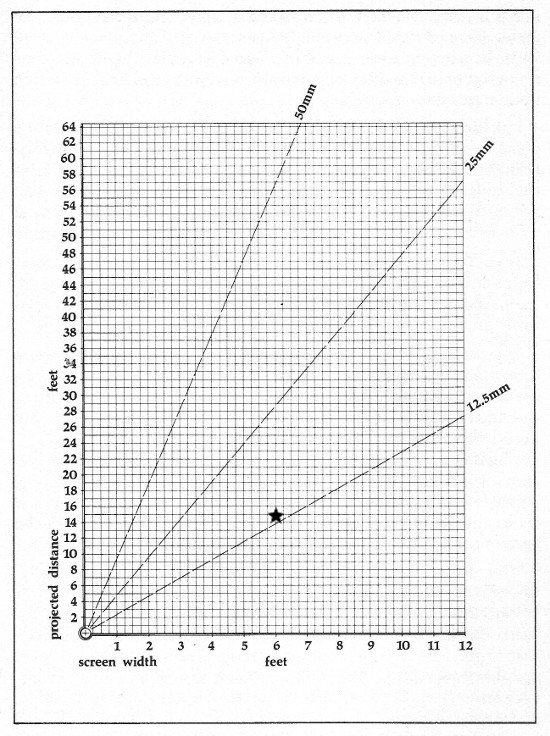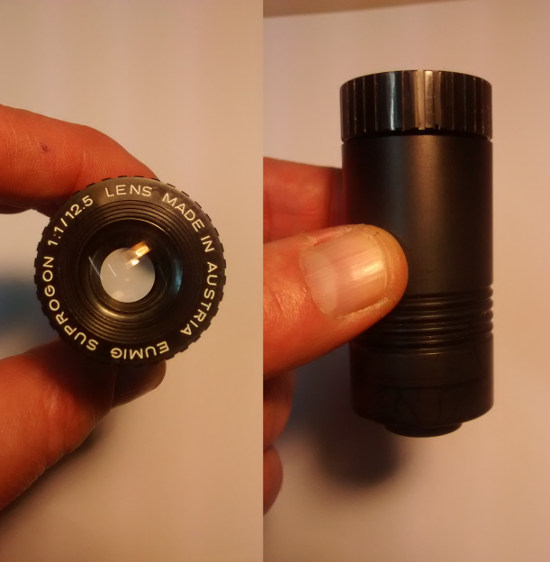|
Author
|
Topic: My Elmo !ens Adapter!
|
|
|
|
|
Shane C. Collins
Expert Film Handler

Posts: 107
From: Williamsport, PA, USA
Registered: Oct 2016
|
 posted January 13, 2019 02:09 PM
posted January 13, 2019 02:09 PM




I can attest to the quality of those Bolex "hifi" lenses. I currently am using a Bolex zoom on my Sankyo 2000, and a Bolex prime lens, that is better, on the Elmo FP8-C. It appears others here on the forum use these lenses, but for those that have never had one your really missing out. Still my favorite for projecting, especially the prime.
--------------------
Projectors: Bolex 18-5L Super, Bolex 18-5 regular 8mm, Elmo FP8-C
| IP: Logged
|
|
|
|
|
|
|
|
|
|
|
|
|
|
Shane C. Collins
Expert Film Handler

Posts: 107
From: Williamsport, PA, USA
Registered: Oct 2016
|
 posted January 14, 2019 07:10 PM
posted January 14, 2019 07:10 PM




Your Dad was correct a good prime lens can never be beat! I've tried various zoom lenses from Schneider, Elmo, etc. Every time I go back to the Bolex 1.3 prime lens. I'm not saying Bolex made the best lenses in the world, but their prime lenses are very very good. To be honest it's the only prime lens I own, the rest are zoom lenses. The prime lens not only allows more light to transmit on screen, but it also allows the grain to shimmer, and the sharpness is unbelievable. I do have to project a smaller image, but that's OK because Super 8 seems to look best within it's limitations.
--------------------
Projectors: Bolex 18-5L Super, Bolex 18-5 regular 8mm, Elmo FP8-C
| IP: Logged
|
|
|
|
Matthieu van der Sluis
Master Film Handler
Posts: 373
From: Barendrecht, The Netherlands
Registered: Aug 2017
|
 posted January 15, 2019 03:52 AM
posted January 15, 2019 03:52 AM




Ah I see, that's what Prime stands for.
Sorry I did not know the word for it.
I thought that Prime stood for most special serie lens.
A fixed lens without zoom.
That indeed is the best, as for photography as well for projection.
Maybe I need to go for a lens like that as well.
I have a projectionroom that will be finished end of February. It's for my work, where I can do the ISF-calibrations on the digital videoprojectors I sell, but there we will do all the Super8 projection as well, on a fixed screen in a shadowbox enviroment.
A Prime lens is suitable for a fixed setup.
Is there a way to calculate which Primelens I need, to fill this screen completely?
- My screen is 135cm high
- The projectorlens is about 4.5 meters from the screen, which can be less, but not more.
The screen is 16:9 but we have black lightabsorbing curtains on the left and right, so we can make it 4:3.
Oh man,... the ideas and knowledge I get from this forum is amazing.
| IP: Logged
|
|
|
|
|
|
Shane C. Collins
Expert Film Handler

Posts: 107
From: Williamsport, PA, USA
Registered: Oct 2016
|
 posted January 15, 2019 07:08 PM
posted January 15, 2019 07:08 PM




I found this definition for a prime lens at Wikipedia.
The term prime has come to mean the opposite of zoom—a fixed-focal-length, or unifocal lens.
While a prime lens of a given focal length is less versatile than a zoom lens, it is often of superior optical quality, wider maximum aperture, lighter weight, and smaller size. These advantages stem from having fewer moving parts, optical elements optimized for one particular focal length, and a less complicated lens formula that creates fewer optical aberration issues. Larger maximum aperture (smaller f-number) facilitates photography in lower light, and a shallower depth of field.
--------------------
Projectors: Bolex 18-5L Super, Bolex 18-5 regular 8mm, Elmo FP8-C
| IP: Logged
|
|
|
|
|
|
Paul Adsett
Film God
Posts: 5003
From: USA
Registered: Jun 2003
|
 posted January 16, 2019 09:52 AM
posted January 16, 2019 09:52 AM



Prime lenses were the norm on Standard 8mm cameras and projectors prior to the early 1960's. This is the main reason, along with the inherent superiority of double 8mm roll film going through an all metal gate, that 8mm Kodachrome film from this period looks so stunning. Super 8 of course has about a 40% larger frame, but the ubiquitous zoom lenses on super 8mm cameras and projectors, along with the nasty plastic super 8mm camera cartridge, compromises what can be achieved. DS8 film, run through a Bolex or Pathe DS8 camera fitted with prime lenses must be something to see.
--------------------
The best of all worlds- 8mm, super 8mm, 9.5mm, and HD Digital Projection,
Elmo GS1200 f1.0 2-blade
Eumig S938 Stereo f1.0 Ektar
Panasonic PT-AE4000U digital pj
| IP: Logged
|
|
|
|
|
|
Paul Adsett
Film God
Posts: 5003
From: USA
Registered: Jun 2003
|
 posted January 16, 2019 11:44 AM
posted January 16, 2019 11:44 AM



Hi Shane, it's a small world! I used to live in Montoursville working at Litton Electron Devices (now E3) on Westminster Drive in Faxon. Many happy memories of working there, among them it was where I first met my beautiful wife. They don't call that area 'Gods Country' for nothing. Glorious scenery, great trout fishing, and wonderful people. I still miss it.
We get to WMPT every few years, maybe next time we could get together for a cup of coffee and chat about film collecting.
--------------------
The best of all worlds- 8mm, super 8mm, 9.5mm, and HD Digital Projection,
Elmo GS1200 f1.0 2-blade
Eumig S938 Stereo f1.0 Ektar
Panasonic PT-AE4000U digital pj
| IP: Logged
|
|
|
|
|
|
|
|
|
|
|



 UBBFriend: Email this page to someone!
UBBFriend: Email this page to someone!
 Printer-friendly view of this topic
Printer-friendly view of this topic







![[Smile]](smile.gif)






